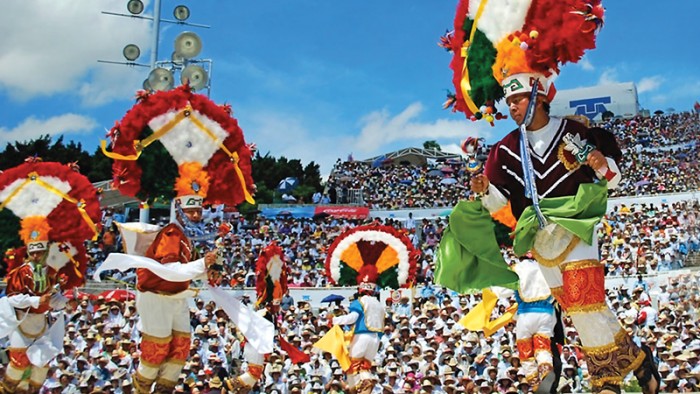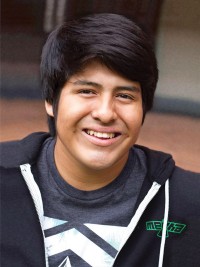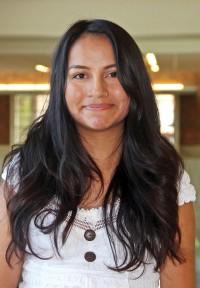Dance of the Storytellers

It would have been the experience of a lifetime. Especially for a nine-year-old.
It was East Los Angeles, 2005, and Romario Bautista was asked to participate in his community’s annual cultural festival.
The Danza de la Pluma ceremony—“Dance of the Feather”—is a cherished tradition of one of Mexico’s indigenous groups, the Zapotec of the state of Oaxaca. The danza reenacts the tribe’s fierce battles against invading Spanish conquistadors in the 1500s.
As Mexicans have moved to the United States over the years, the danza ceremony has moved with them, binding migrant communities in the US to their homeland and preserving culture and history.
Alas, joining in a danza is no small task. The dances are exceedingly elaborate, taking months or even years to master. Unfortunately, Bautista’s family couldn’t commit the time and he couldn’t join in the experience.
But any lingering disappointment he may have felt at the lost opportunity has been channeled into a new way of appreciating his heritage. Now in his 20s, Bautista, a UO

Romario Bautista
double-major in anthropology and journalism, has seized on the chance to revisit the danza as a social scientist.
Bautista, along with two other UO students, traveled to Mexico City last spring to explore how indigenous peoples have passed along their history for more than five centuries through traditions such as danzas.
At the heart of the danza is a cultural preservation technique as old as human history: storytelling.
“What my grandparents taught me is, you can tell a story many different ways, but what’s most important is that the message you are trying to tell stays the same,” Bautista said. “The dance has evolved physically, but spiritually and emotionally it’s still the same exact thing as it was centuries ago.”
A God without a Foot
Every year, villagers in one of Mexico’s southernmost states hold a festival that recognizes their history. They eat, they dance, they reunite as a community.
Nearly 1,800 miles away, in a neighborhood of East Los Angeles, a group carries out a version of that same ceremony.
Most people at each event have never seen the other one going on in the neighboring country. And yet the two ceremonies are similar; this phenomenon fascinated Bautista, inspiring him to investigate how this came to be.
Bautista is studying how Mexican migrants to the United States use the Danza de la Pluma and other cultural traditions to maintain ties to their history and homeland. With help from anthropology professor Lynn Stephen, he is looking at “transnationalism”—a research area that addresses the growing connections among peoples across national boundaries, and the diminishing significance of those boundaries.
“Even though there’s a border between us,” Bautista said, “that culture, that language, that tradition fortunately gets carried over.”
Bautista was part of a contingent of three UO students who traveled to Mexico last spring with Ana-Maurine Lara, assistant professor of anthropology. They attended a conference on tribal traditions at the Mexican National Museum of Anthropology in Mexico City, visited historical sites and also met with elders and other experts to bolster their research.
The students gathered material for a yearlong independent study course on the culture of storytelling among Mexico’s indigenous people. For this comprehensive project, the trio is producing research and conference papers and a documentary video, while developing curriculum for college-level courses and community-based classes.
In Mexico, Bautista conducted research that built on his personal knowledge of danza ceremonies. He learned that the danzas are as diverse as the many indigenous peoples of Mexico.
Through elaborate rituals, prayers and intricate dances, elders have long relied on danza ceremonies to pass down tribal history to the next generation and preserve cultural identity. Each tells a story—for example, how the sun and earth were created, or the adventures of a god who is missing a foot (dancers hold their own foot at an awkward angle while they perform).
Each movement carries a specific meaning—it can take years to learn all of the intricacies to some of the more complex danzas that extend over days.
Among the Zapotec, current generations perform danzas in the villages where they have been held for more than 500 years. Likewise, tribal descendants who have settled in the US—primarily in California—carry out those same traditions in their communities.
Documenting for Future Generations
Most challenging for Bautista has been tracking down what little research is available in written form.
Much of Zapotec history is handed down orally, through the danzas and other means. The desire to document these practices for future generations inspired Bautista to pursue his project.
In Oaxaca, he interviewed villagers across multiple generations, seeking to learn how their participation in this active form of storytelling has shaped them. He visited the museum in Santa Ana del Valle, in the town where his parents were born, and he interviewed a village elder about the Zapotecs’ past.
“There’s so much history that even community members don’t know,” Bautista said.
Back in his hometown of East Los Angeles, Bautista met with migrants and others with family connections to Oaxaca who participate in the local festival. He found that the longstanding tradition they have imported from Mexico provides a cultural link for those who may have never set foot in that country, but have ancestral ties there.
One of them, in fact, is much like that nine-year-old boy who was denied the danza years ago. Bautista’s cousin, Jose Garcia, was also nine when he first took part in the ceremony, and he remains active in the tradition today, more than a decade later.
“He doesn’t know what Mexico is like,” Bautista said. “He’s never seen it except through pictures, he’s never set foot there. But how he speaks the language and practices the dances . . . I feel like he’s been there his whole life.”
Bautista is now working with Zapotec communities on both sides of the border, regarding their shared practice of the venerable Danza de la Pluma festival. He’s gathering material for a documentary that he’ll eventually show to both groups.
“People in Oaxaca don’t know how much (the danza) is practiced in the US,” Bautista said. “And a lot of those who migrated here don’t get to see how it is practiced back in Mexico.”
No Instruction Manual
There’s no instructional manual for danza ceremonies. No video demonstrating the intricate dance steps involved. Don’t look for a guidebook on the prayers and rituals. None exists.
So how has this knowledge been handed down to younger generations over 500 years? That’s Perla Alvarez’s research question. Alvarez was one of the other UO students who traveled to Mexico City last spring.

Perla Alvarez
Alvarez’s ancestors were native to Mexico, although she doesn’t know their tribe. The generations before her were taught that being indigenous was shameful and somewhere in her family tree, the knowledge of her ancestral roots was lost.
Alvarez, an ethnic studies major, sees her research as a way of resurrecting traditions and showing pride in her family history. “It’s motivated me to explore more about where my grandparents came from, where my parents came from, and to find out more about myself,” she said.
During the trip to Mexico City, Alvarez interviewed tribal elders about the danzas, gleaning bits and pieces of information that would help answer her questions and provide the foundation for a research paper.
The research took persistence and patience. Alvarez worked methodically to build a list of sources, asking each person with whom she spoke to recommend another.
Cultural history is often passed down casually, informally—and spontaneously. Family members linger after a meal, a question gets asked, a conversation takes a turn and suddenly an elder is opening a door on a legacy that reaches back centuries.
The danzas themselves can be very formal affairs.
The family named by the village elder to organize that year’s danza begins working months in advance. They visit the homes of other families whom they ask to participate, and then the parties retreat to a special room with an altar. The visiting family extends the invitation to join the danza in a very solemn and deliberate fashion, with each family standing on opposite sides of the altar.
Given these types of intimate family and tribal rituals, not everyone is eager to discuss danzas with a complete stranger. Alvarez had to build trust and promise not to publicize sacred prayers, ceremonies and teachings.
Occasionally, though, she enjoyed true moments of discovery.
One evening during her trip to Mexico, she was sitting at a dinner table with elders who casually began discussing “codices”—elaborate visual histories that the tribes have passed down over centuries (see “Decoding the Codex” for the story of the third UO student who accompanied Alvarez and Bautista to Mexico). The elders went into their meanings, how the documents capture the tribes’ history and the stories they tell.
Such conversations, Alvarez said, “are where a lot of learning comes from.”
On her trip, she also observed a number of dances that are part of the danza traditions she is studying, called Mexica danza.
“I got really tired, but I enjoyed being tired, and I think that’s the spiritual component of danza,” Alvarez said. “You are offering the dance, the energies, to the elders. That’s what danza and the ceremonies are all about: appreciating yourself, your body and spirituality, and the ability to be present.”
—Jim Murez
Top photo caption: The Danza de la Pluma, an annual Zapotec ceremony, has special meaning for UO student Romario Bautista. He is exploring how the ritual crossed the border from Oaxaca, Mexico, to his hometown of East Los Angeles.


 Twitter
Twitter Facebook
Facebook Forward
Forward